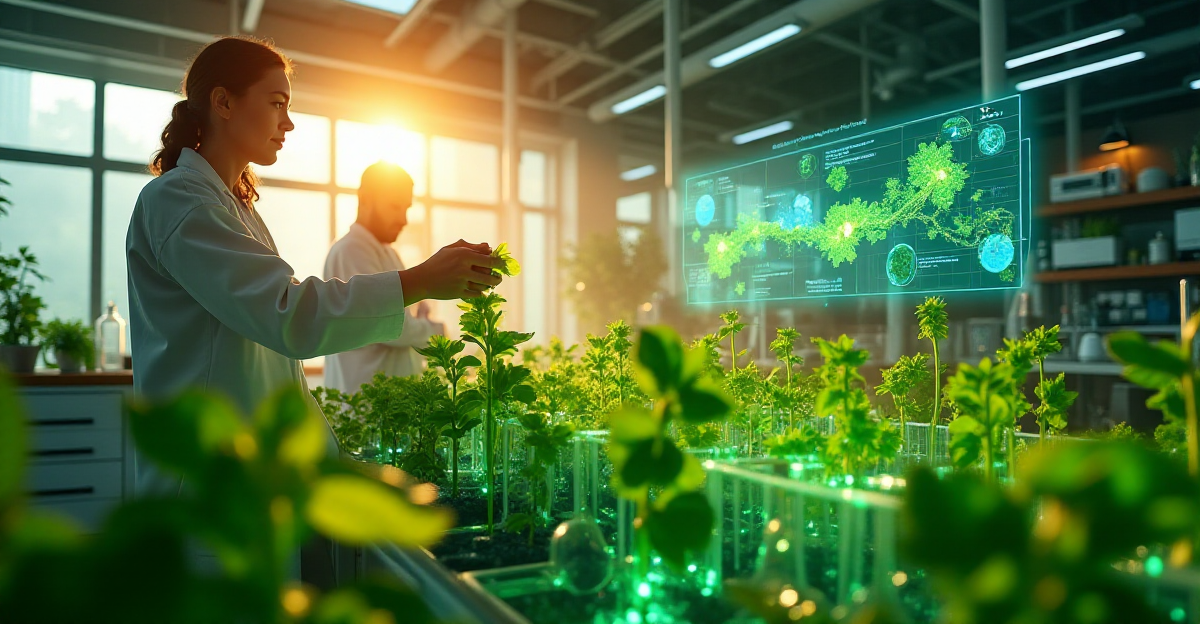Nature’s method of turning sunlight into energy is photosynthesis, which also is quite important in absorbing carbon dioxide from the atmosphere. The mechanism of photosynthesis, its significance in the global carbon cycle, and how researchers are looking at ways to improve photosynthesis to help to slow down climate change will be discussed in this paper. Personal thoughts on the wonder of photosynthesis will underline its possibilities in the struggle against world warming.
Table of Contents
- How Photosynthesis Works: The Key to Life and a Weapon Against Climate Change
- The Role of Photosynthesis in the Carbon Cycle
- Can Enhanced Photosynthesis Help Combat Climate Change?
- Extra’s:
How Photosynthesis Works: The Key to Life and a Weapon Against Climate Change

Have you ever given any thought on the source of food for plants? Alternatively, how does our breathing acquire the oxygen? The solution rests in a fundamental mechanism known as photosynthesis. From the smallest germs to the tallest trees, this process is the basis of life on Earth. Still, photosynthesis is also growingly crucial for the fight against climate change.
Photosynthesis: Nature’s Energy Machine
Plants, algae, and some microorganisms use photosynthesis basically to turn sunlight into energy. Chlorophyll is a green pigment they employ to collect solar light energy. This absorbed light energy then splits water molecules. The oxygen produced by this process enters the environment and is the very air we exhale.
The Carbon Cycle and Climate Change
The way photosynthesis affects the carbon cycle is another absolutely vital component. Plants employ the hydrogen ions from water together with CO2 from the environment to generate glucose. The food supply of a plant is glucose, a kind of sugar. Once the plant dies and breaks down, this mechanism stores carbon in its tissues then releases it back into the atmosphere.
Maintaining a stable temperature depends on CO2 absorbed and CO2 released being in balance. Sadly, though, by burning fossil fuels and spewing extra CO2 into the atmosphere we are upsetting this equilibrium. Like a blanket, this surplus “CO2 traps heat and warms our planet.”
How Photosynthesis Can Help Combat Climate Change
How therefore may we employ photosynthesis to combat global warming? The solution rests on carbon sequestration, the technique of extracting CO2 from the atmosphere and storing it. Excellent approaches to boost carbon sequestration are forest restoration and tree planting. Like massive CO2 sponges, trees absorb and store CO2 as they develop.
We can also investigate methods to improve photosynthesis in current plants so they might more effectively absorb CO2. Development of crops capable of capturing and storing more CO2 by scientists could help to drastically lower atmospheric CO2 levels.
What Can You Do?
There are things everyone of us can do to boost photosynthesis and assist in the fight against climate change even while researchers work on these answers.
- Plant a tree: Every tree planted helps absorb CO2 and improves the environment.
- Reduce your carbon footprint: Take public transportation, walk or bike instead of driving, and reduce your energy consumption at home.
- Support sustainable practices: Choose products made from recycled materials, and buy from companies that prioritize environmental sustainability.
Understanding photosynthesis and acting to assist this vital process will enable us to contribute to a better earth for present and next generations.
The Role of Photosynthesis in the Carbon Cycle

Have you ever given any thought to how your backyard’s trees help to maintain the health of our planet? They are doing far more than only provide fresh air and cover. They are also quite important in the carbon cycle, the natural mechanism maintaining the equilibrium of the temperature of our earth. And photosynthesis is the fundamental actor in this process. Plants derive their energy from sunlight via photosynthesis. Still, it is also quite important in controlling the atmospheric carbon dioxide levels.
Consider a rich, vibrantly alive rainforest. A powerhouse of photosynthesis, this dynamic environment is. Constant carbon dioxide absorption from the air by the rainforest’s trees allows them to flourish. Tissues of the trees store the carbon dioxide, therefore eliminating it from the atmosphere. Sadly, though, human activity including deforestation is upsetting this equilibrium. Cut down trees send the stored carbon back into the atmosphere, therefore aggravating climate change.
Photosynthesis: The Earth’s Natural Air Purifier
Let’s probe further into the mechanisms of photosynthesis. This amazing technology turns sunlight into energy. This approach is used by some bacteria, algae, and plants. Plants mix carbon dioxide from the atmosphere with water during photosynthesis. They convert this mix into glucose, their food supply, using sunlight as energy. Plants cannot grow and flourish without this glucose. More importantly though, the carbon from the carbon dioxide locks itself inside the tissues of the plant.
Consider all of the trees on Earth! Absuming carbon dioxide, they store it for years like massive carbon sponges. This is the reason forests are sometimes referred to as carbon sinks: they are absolutely essential in carbon absorption and storage. As you have certainly heard, though, people are using fossil fuels at shockingly rapid rates. Mass carbon dioxide emissions from this disturb the natural carbon balance in the atmosphere. Acting like a blanket, this surplus carbon dioxide traps heat and warms the earth. Major component of climate change, this phenomena is called global warming.
The Impact of Climate Change on the Carbon Cycle
How the carbon cycle itself is being affected by climate change could be of interest to you. Rising global temperatures are, however, altering plant development, rates of decomposition, and ocean capacity to absorb carbon dioxide. More frequent and severe droughs brought on by warmer temperatures, for instance, can slow down plant growth and lessen their capacity to absorb carbon dioxide. This makes safeguarding our woods absolutely vital!
One fragile mechanism is the carbon cycle. To stop more disturbance, we must understand and guard it. Your daily life can be improved by little adjustments you do. You might, for instance, help neighborhood tree-planting projects, choose goods created from sustainable materials, and cut your energy use. Though seemingly little, these behaviors can significantly help to slow down global warming and safeguard the carbon cycle. Recall, every little action counts!
Can Enhanced Photosynthesis Help Combat Climate Change?

Imagine a world in which supercharged plants collect vast volumes of carbon dioxide from the atmosphere and turn it into electricity. This is not science fiction; rather, “enhanced photosynthesis’s promise.” Crucially in reducing climate change, photosynthesis is the process by which plants convert carbon dioxide (CO2) into energy using sunshine. Burning fossil fuels among other human activities has sent too much CO2 into the atmosphere, upsetting the natural carbon cycle and fueling world warming.
Researchers are vigorously investigating creative approaches to use photosynthesis to fight global warming. Strategies meant to make plants more effective in absorbing and storing CO2 are referred to as enhanced photosynthesis. This strategy has great potential; several fascinating advancements are under progress.
Strategies for Enhancing Photosynthesis
Scientists are working on several methods to improve photosynthesis, each with special merits:
- Genetic Engineering: Researchers are modifying plant genes to improve their ability to absorb and convert CO2. By tweaking genes related to how plants take in carbon, how they absorb light, and other essential processes, they aim to create plants that can capture more CO2 and convert it into biomass more efficiently.
- Improved Nutrient Management: Plants need essential nutrients like nitrogen and phosphorus to grow and photosynthesize efficiently. Optimizing nutrient levels in soil can help plants maximize their photosynthetic capabilities and capture more CO2. For example, researchers are investigating the use of nitrogen-fixing bacteria to enhance nitrogen availability in soil, leading to increased plant growth and CO2 absorption.
- Climate Change Mitigation: It might surprise you to learn that elevated CO2 levels can actually stimulate photosynthesis in some plants, especially those adapted to arid regions. This is because higher CO2 levels can reduce water loss through transpiration. However, these effects are complex and depend on various factors like temperature, water availability, and plant species.
The Potential of C4 Crops
Development of C4 crops is one fascinating illustration of enhanced photosynthesis research. Like corn and sugarcane, C4 plants have evolved a more efficient photosynthetic pathway that lets them more readily take CO2 in hot and dry environments. To employ the C4 photosynthetic pathway, scientists are investigating methods to genetically alter crops like rice and wheat, thereby maybe increasing carbon sequestration and yielding more food.
One encouraging approach for enhanced photosynthesis is the C4 pathway. Leading investigations to create C4 rice is the International Rice Research Institute (IRRI). Their novel variety of rice absorbs noticeably more CO2 than conventional rice types. Global food security and climate change prevention could be much enhanced by this study.
The Role of Enhanced Photosynthesis in a Sustainable Future
Though enhanced photosynthesis has great promise, it is not a magic bullet. Other climate change mitigating techniques include renewable energy and carbon capture technology must be matched with this one. Still, enhanced photosynthesis may be quite important in determining a more sustainable future. Among the difficulties and restrictions are the possibility of unexpected repercussions from genetic changes and the necessity of thorough investigation and development. However, by means of ongoing investment in enhanced photosynthesis research, we may leverage natural resources to build a more robust and sustainable food system and so lowering our carbon footprint.
Extra’s:
If you’re interested in learning more about the intricate processes that shape life on Earth, you might be interested in our post “The Science Behind DNA Ancestry Testing: What Your Genes Can Reveal.” This post delves into the genetic makeup of individuals and how it can be used to trace ancestry and understand genetic relationships. Additionally, exploring the concept of keystone species in “The Vital Role of Keystone Species: How One Species Can Shape an Ecosystem” can provide further insight into the complex interactions within ecosystems, which are crucial for understanding the impact of climate change on biodiversity.
For further information on the potential of photosynthesis in mitigating climate change, exploring external resources is essential. The article “Plant CO2 uptake rises by nearly one third in new global estimates | ScienceDaily” provides a comprehensive overview of recent scientific research highlighting the significant role of plants in absorbing carbon dioxide from the atmosphere. Additionally, the article “Enhanced Photosynthesis – Geoengineering Monitor” delves into the possibilities and challenges of enhancing photosynthesis through technological interventions, offering a glimpse into potential future solutions for climate change mitigation.












1 thought on “How Photosynthesis Could Help Fight Climate Change”